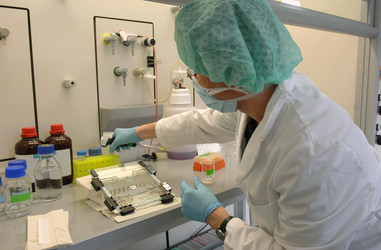- No products in the cart.
Deionized water, commonly referred to as DI water, is water that has had any additional ions from impurities filtered out. This filtration is deionization. The water passes through two ion exchanges, one which removes excess positively charged ions and the second, which removes the excess negatively charged ions.
These impurities are just other compounds that the water has come into contact with like salt or metals. With these additional ions removed, the water remaining is pure, deionized water.

DI Water’s purity can be seen through a conductivity test. Conductivity measures electric current density within an electric field. Sea water has higher conductivity than fresh water because of the large amount of salt dissolved within it. The presence of metals in water will also result in a high conductivity. DI water will have a low conductivity reading since those excess mineral ions are removed.
DI Water is essential to laboratory work, and by extension, critical to the medical industry. It is even indispensable when it comes to managing medical devices.
DI Water in the Medical Device Industry
When it comes to medical devices, the purity of the DI water is of vital importance to their processes of safety, cleanliness and maintenance.
Hemodialysis
According to the CDC hemodialysis patients can use anywhere from 300-600 liters of water a week. The water needs to be very clean in order for those suffering from renal issues to be able to filter the toxins out of their body with lower kidney function. These patients are at higher risk of complications from unclean water being used, so DI water is essential for their safety. It is vital to keep large quantities of DI water available in preparation for this procedure.
Ozone Sterilization
For reprocessing medical equipment, ozone can be used as a sterilizer for a variety of pieces including silica, steel, glass, ceramic and more. DI water is used to create steam in this reaction that separates an oxygen ion into the ozone used for sterilization.
Pasteurization
For non-invasive medical devices, DI water can be used in a pasteurization process for sterilization. The water is heated to high temperatures for a long period of time in order to get rid of lingering bacteria. This allows medical equipment to be reprocessed for additional use instead of being discarded.
Decontamination
In some cases, DI water is preferred over tap water. When decontaminating equipment, tap water isn’t suitable because it is treated with chemicals like chlorine, fluoride and numerous others. These create buildup on the equipment. However, keep in mind that DI water does not have bacteria filtered out, which limits its decontamination abilities. But it can be used to create steam for decontamination.
Preventing Build Up and Corrosion
Medical Devices need high quality water to function properly. Any buildup, corrosion, or discoloration within them could cause a malfunction that could have serious consequences for a patient. To keep the equipment running efficiently the purity of DI water is the best option.
Cleaning
Clean instrumentation is a vital part of patient care and ensuring medical device success. Improperly cleaned equipment can increase the risk of infection. It is common for DI water to be the water source used by instrument washers that rinse and clean medical equipment.
Laboratory Solvent
DI water is a perfect laboratory solvent because it is free of contaminants and can form important solutions. Medical device cleaners are comprised mostly of deionized water with the needing cleaning agents added in.
NOTE:
It is important to regularly test your DI water quality to be sure it is free from harmful contamination. Also, before using it in a new procedure, check regulations to see what grade of water is required. Some systems may allow potable water or DI water but others require UV or RO water, which is undergoes a different cleaning process than DI water.
Types of DI Water
There are three different types of DI Water, which are marked by different quality requirements.
Type 1
Type 1 is the cleanest type of DI water, meaning it has the lowest levels of contaminants in it. This is the type you will find used for medical devices.
Type 2
Type 2 allows for a slightly higher level of contaminants but, it is still pure enough that it is commonly used by laboratories and food grade products.
Type 3
This has the least restrictive requirements of the three types and it is used for general cleaning purposes.
Conclusion
DI water is essential to all laboratory industries, not only medical. Lab Pro can answer any questions that you may have regarding high volume processes, sustainable DI systems, supply integrity, and more. It is irreplaceable as a solvent, blank check, and cleaner.
For over 40 years, Lab Pro Inc. has been committed to delivering the highest quality lab grade deionized water, ESD protection, laboratory and cleanroom PPE supplies to medical device and electronic manufacturing laboratories worldwide. To learn more, visit the biggest Lab Supply showroom in California, or contact us online or at 888-452-2776.
References
HLD pasteurization process. (n.d.). Retrieved February 16, 2021, from https://www.arjo.com/en-us/solutions/reprocessing/hld-pasteurization-process/
Other sterilization methods. (2016, September 18). Retrieved February 16, 2021, from https://www.cdc.gov/infectioncontrol/guidelines/disinfection/sterilization/other-methods.html
Timmons, M. (2019, December 03). De-ionization 101. Retrieved February 16, 2021, from https://www.uswatersystems.com/blog/de-ionization-101
Water for instrument processing. (n.d.). Retrieved February 16, 2021, from https://www.infectioncontroltoday.com/view/water-instrument-processing
Water use in dialysis. (2020, October 15). Retrieved February 16, 2021, from https://www.cdc.gov/dialysis/guidelines/water-use.html
What is di water and other water treatment terms explained. (n.d.). Retrieved February 16, 2021, from https://www.uswatersystems.com/di-or-deionized-water-terms-and-information#:~:text=DI%20water%20is%20water%20that%20has%20had%20all,water%20are%20dissolved%20salts%2C%20a%20type%20of%20ion.












































